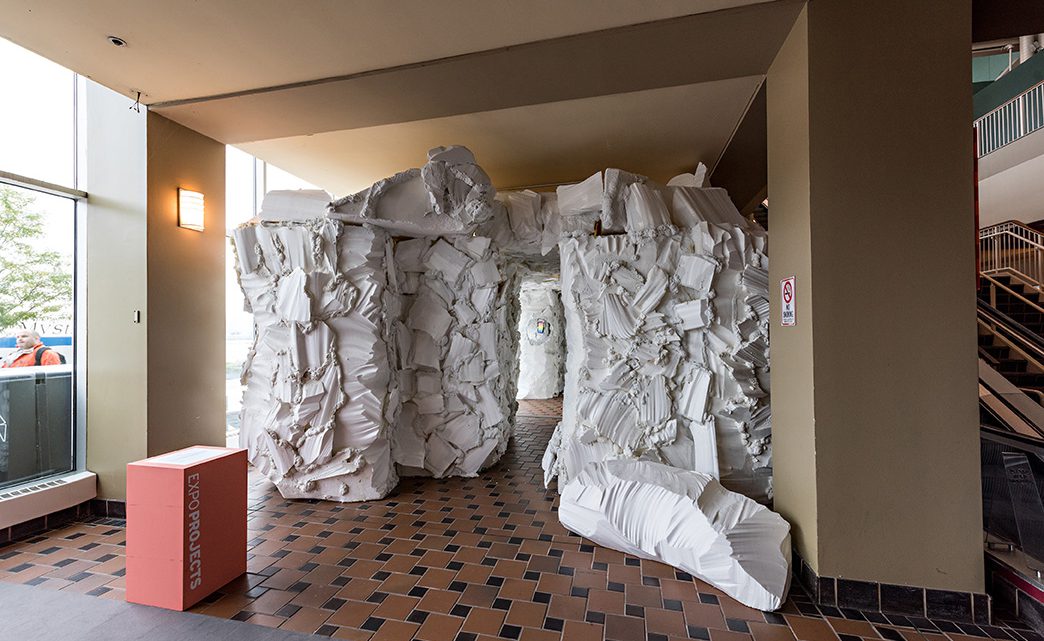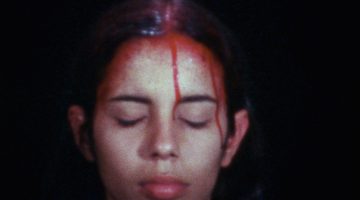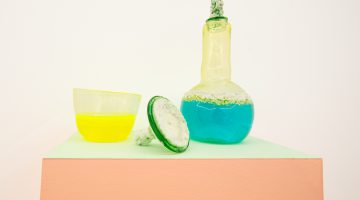EXPO Chicago 2016
September 22-25
Navy Pier, Chicago IL
One of the ways in which EXPO Chicago differentiates itself from other art fairs around the country is through its programmatic offerings—two of those being IN/SITU and PROJECTS. Both install work throughout the fair that is intended for viewing and experiencing rather than buying. These pieces may very well be for sale, but they are works that are typically large and installation based—not generally found inside of a dealer’s booth. An outside curator arranges IN/SITU while EXPO PROJECTS is an organized selection of emerging and established artists represented by participating galleries in the fair.
This year’s IN/SITU program, entitled A Break in the Code, was curated by Diana Nawi of Pérez Art Museum Miami. Despite a vague curatorial statement about “underlying structures that order and shape the world around us,” works that activated their given and sometimes difficult spaces made a significant statement among the fair. Situated along the perimeter of the space and in the center aisles, pieces were demarcated by the signature EXPO pedestals marked in either gold for IN/SITU or salmon for PROJECTS, with little room to breath. The claustrophobic nature of this presentation is difficult to avoid with 145 galleries and nearly two-dozen other booths reserved for special exhibition spaces. Overall the presentation of the works curated into IN/SITU felt tired, which is not to say they didn’t stand alone as noteworthy works. The subversive political systems had an underlying artspeak to them that felt removed from the actual reality of this particular moment we are in, with the exception of For Freedoms, a project curated by Hank Willis Thomas but presented as part of IN/SITU. There were works, however, that managed to incite a real response within this limited framework.
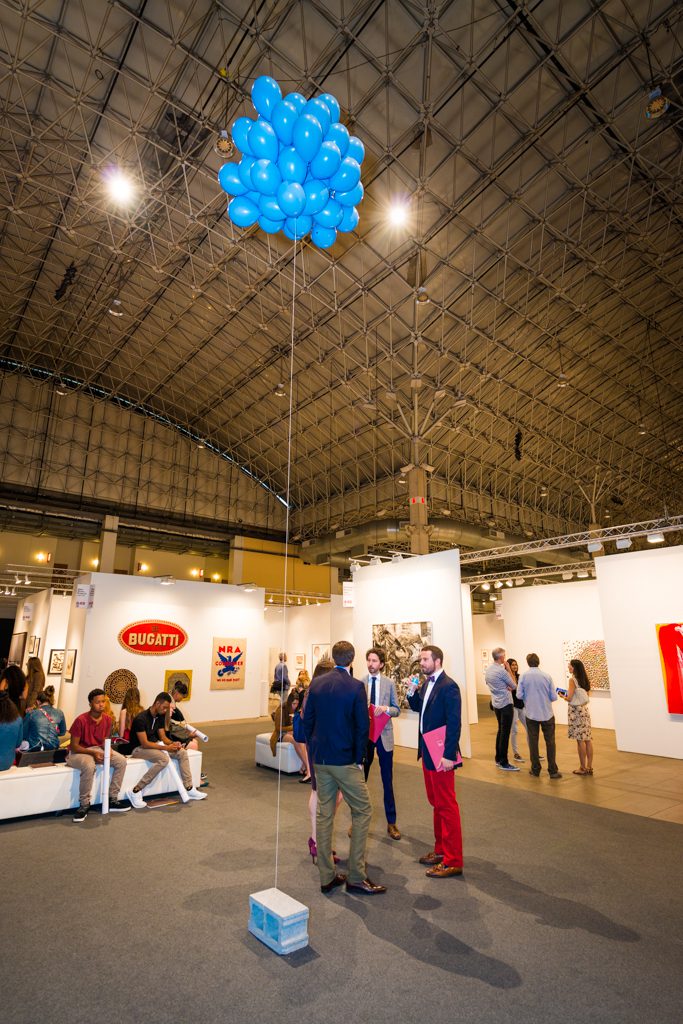
Installation view, EXPO PROJECTS, 2016. Courtesy of EXPO Chicago
A major challenge of the EXPO space, which resides at Navy Pier, is its intensely tall ceilings, which help to make the fair feel more open but can dwarf larger works. Spencer Finch’s (Sky Over Coney Island November 26, 2004, 12:47pm Southwest View Over the Cyclone) (2004) could be found in the middle aisle floating about two stories off the ground. Consisting of too many blue balloons to count tied together in a bunch and suspended by a rope anchored to one cinder block it was a welcome breath of fresh air. Finch’s work hinges on specific moments. This work cites the color above a specific piece of sky in Coney Island with a time stamp. It’s not about whether or not the color is true—the viewer chooses to believe in the sentiment that Finch provides by imaging that place, that time, and that corner of sky for themselves—a welcome respite from the noise of the fair and a moment to center oneself before taking in the other, more heavy, topics on the periphery.
Amalie Jakobsen’s Recursive Demarcation (2016) was the most intellectual presentation within IN/SITU both in form and action. Three forms made of theater blackout fabric about a foot wide were suspended from the ceiling in the shape of an “x”—the top and bottom connected to form two triangles separating the space within a white platform. As a sculptural object the references to formalism were loud but poetic. This installation, however, was actually a stage for a daily performance designed by Jakobsen. Eight dancers wearing black turtle necks, fitted pants, and bare feet (aside from one in zebra print six inch heels) donned sheets of aluminum coarsely cut and molded into wearable sculptures by the artist. They danced with ear buds in their ears to what one would assume was music of their choosing, referencing the silent club scene. The performance lasted about 30 minutes and was transcendent to watch. Each dancer moved strictly to the beat of their own personality with moderately limited mobility due to the sculptural forms surrounding their torsos. The references to dada theatre, abstraction, and cubism held it together visually while the individualization of each performer participating in a modern trend (silent clubbing) made this work extremely dynamic and enjoyable.
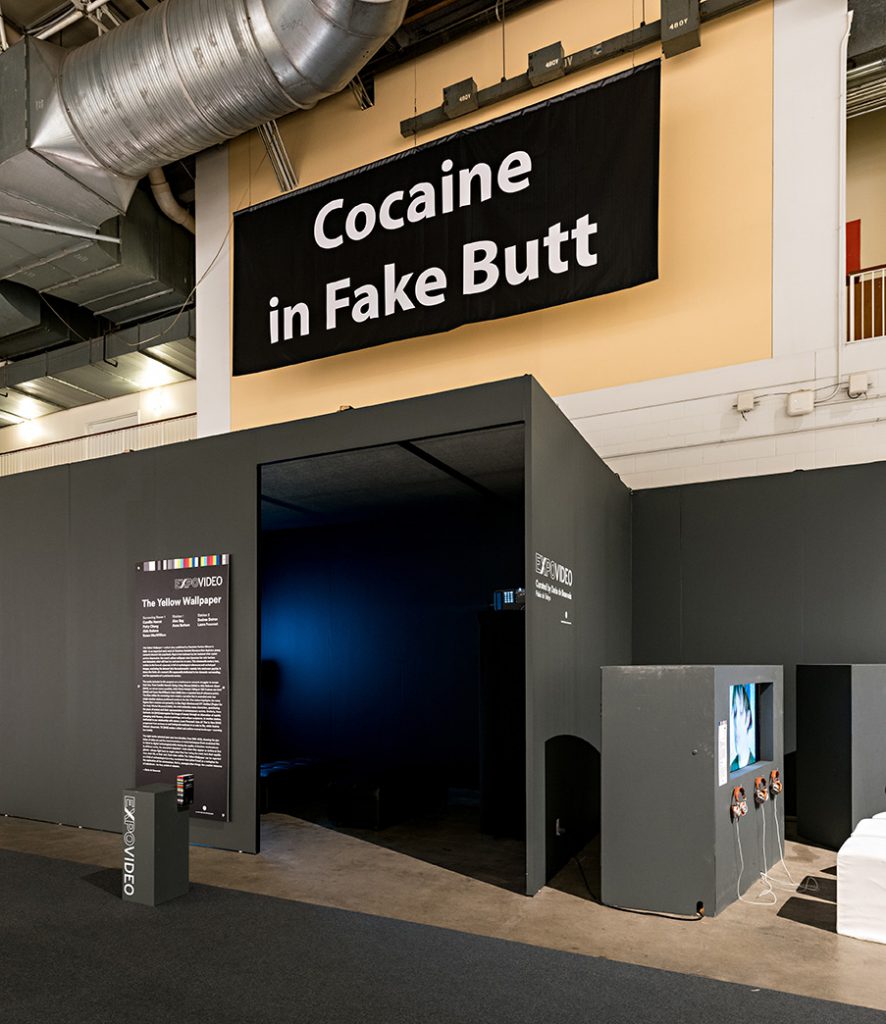
Installation view, EXPO PROJECTS, 2016. Courtesy of EXPO Chicago
Other more political works found their way into IN/SITU. Installed throughout the space in giant graphic text likened to a Lawrence Weiner were phrases such as “Cocaine in Fake Butt.” These are works from the Narco Headlines Series (2015). Julio César Morales’s work unapologetically dives deep into border issues between Mexico and America but with an accessible hand. These headlines are ridiculous but not untrue, bringing attention to the absurdity in the darkness, giving the viewer real pause, which is difficult to do in an art fair context.
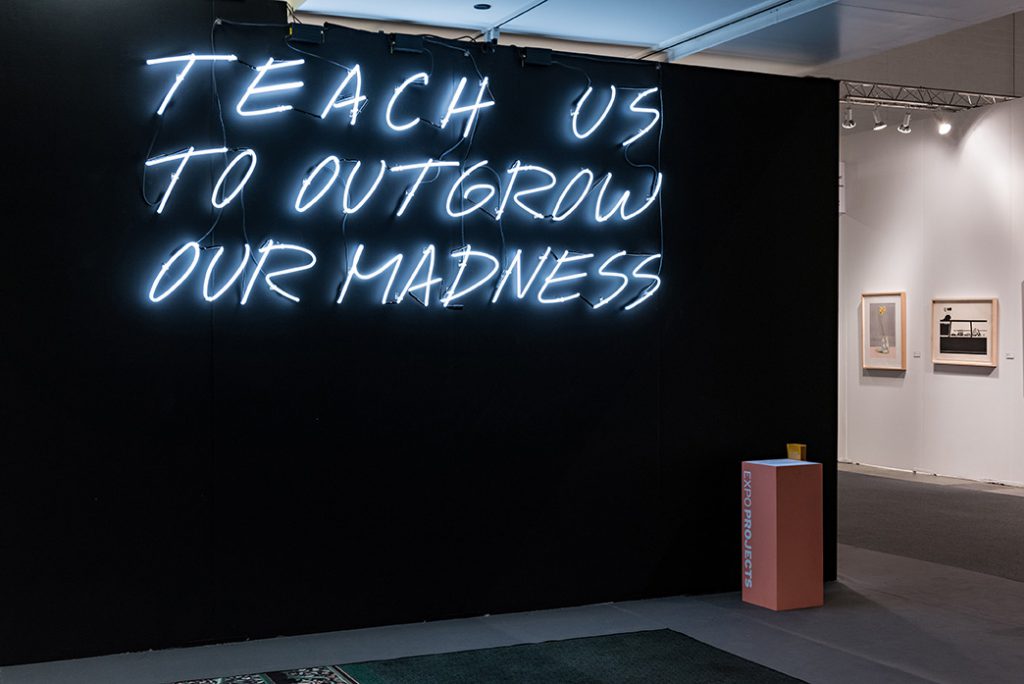
Installation view, EXPO PROJECTS, 2016. Courtesy of EXPO Chicago
Expertly placed on the wall leading into the area where EXPO’s Dialogues program of lectures and conversations took place was Alfredo Jaar’s Teach Us to Outgrow Our Madness (1995). This work, presented by Human Rights Watch, served as a sobering reminder of all things human and intellectual. Inspired by Nobel laureate Kenzaburō Ōe this neon writing on a black wall focuses on an act of observing and learning from past generations. As visitors paused to take selfies in its glow one could only hope that, upon reviewing the photo in its viral form, the message would sink in. That message reading loud and clear: listen.
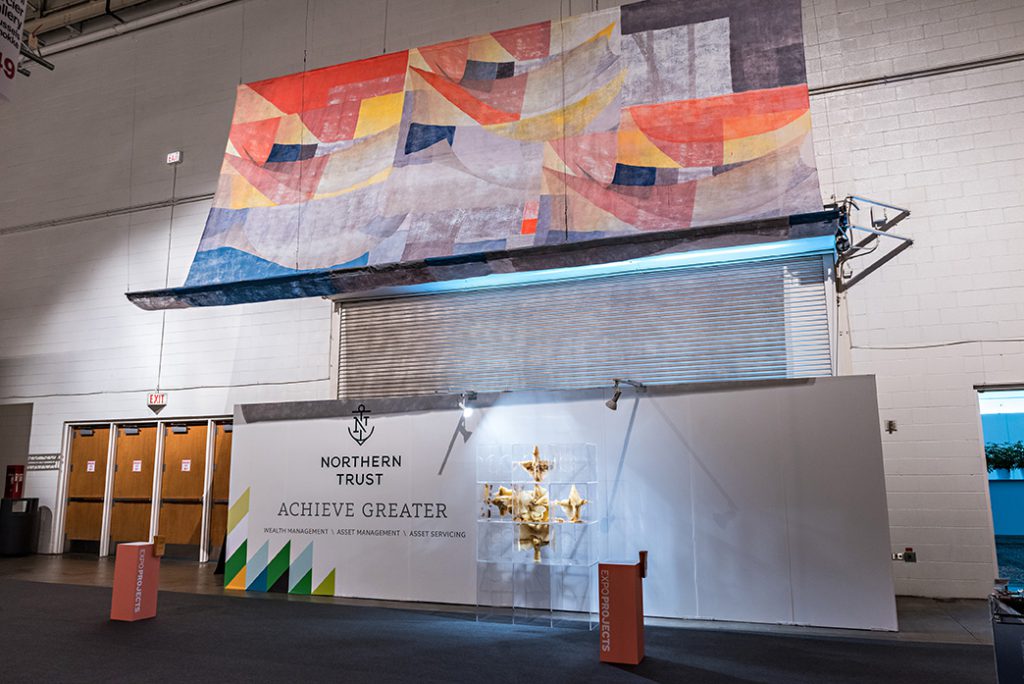
Installation view, EXPO PROJECTS, 2016. Courtesy of EXPO Chicago
Aside from Amalie Jakobsen’s performance piece, the work at EXPO was largely still. Above one of the VIP entrances however, hovered a semi-translucent painting by Anna Kunz entitled Warp (2016). Although this work could easily be chalked up to another abstract painter from Chicago, the creation of the work in the studio is also extremely peformative and builds on the history of happenings and theatre. The bottom of this piece scoops upward towards the ceiling just slightly revealing the underside, which surprisingly is not soaked in paint. The non-woven fiber material catches the paint on the surface while allowing light through, creating a filtering affect for the color in the paint. It mirrors the architecture of the gateway perched above it, while its formal qualities prevent it from floating off into the abyss of an immense space.
Upon exiting the fair, a strange and otherworldly installation invited visitors inside. This cave-like structure made of recycled foam was the creation of Sabina Ott. Because mountains were so high (2016) is an exploration of allegory and directly references Plato; mirrors placed throughout the winding corridors served as a reminder that this particular cave was not a place to hide from individual reality, but rather a space to face one’s self. Digital screens could also be found embedded in the wall with colorful visual fields and text on repeat. While it would have been preferable to have this magnificent work placed inside the walls of the fair proper, its form and experience may have been swallowed up by the vast space.
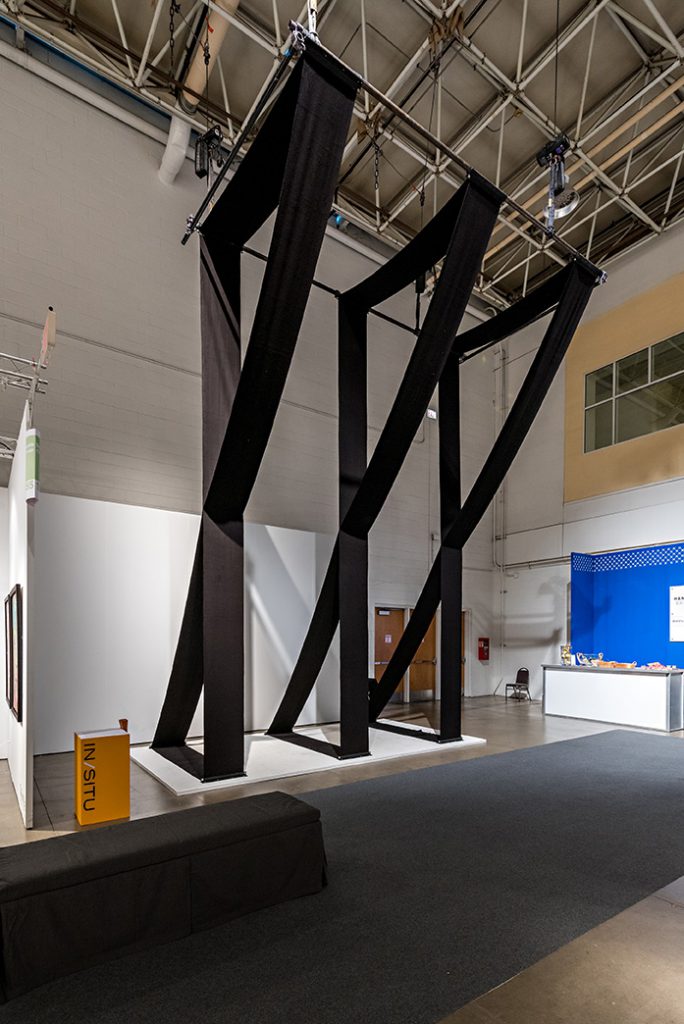
Installation view, EXPO PROJECTS, 2016. Courtesy of EXPO Chicago
The past two years have solidified EXPO’s seat at the international art fair table, and the programs presented at the fair are unique. Speaking critically however, they could be elevated even further. With the knowledge that an art fair functions differently than an art organization or institution, this particular curated iteration of IN/SITU missed the mark in presenting a comprehensive vision. Rather than listing an empty description of the work one is standing before, a more thoughtful caption regarding the artist’s practice and how the piece fits into the overall theme of IN/SITU would serve visitors well. While these programs are geared towards non-collecting visitors of the fair they also provide an opportunity to showcase what is relevant and important to curators who spend their time researching and presenting cultural commodity. Therefore, a clearer curatorial statement or vision, and further descriptions would not only make the experience more enjoyable for fair visitors but would inform collectors of work they should be paying attention to moving forward. There is an opportunity to put the responsibility on the curator to tighten up their program. The emphasis is on the fair and will always be on the fair itself, but these other aspects of EXPO are important entry points for the cultural and economic art market and should be showcased as such.
